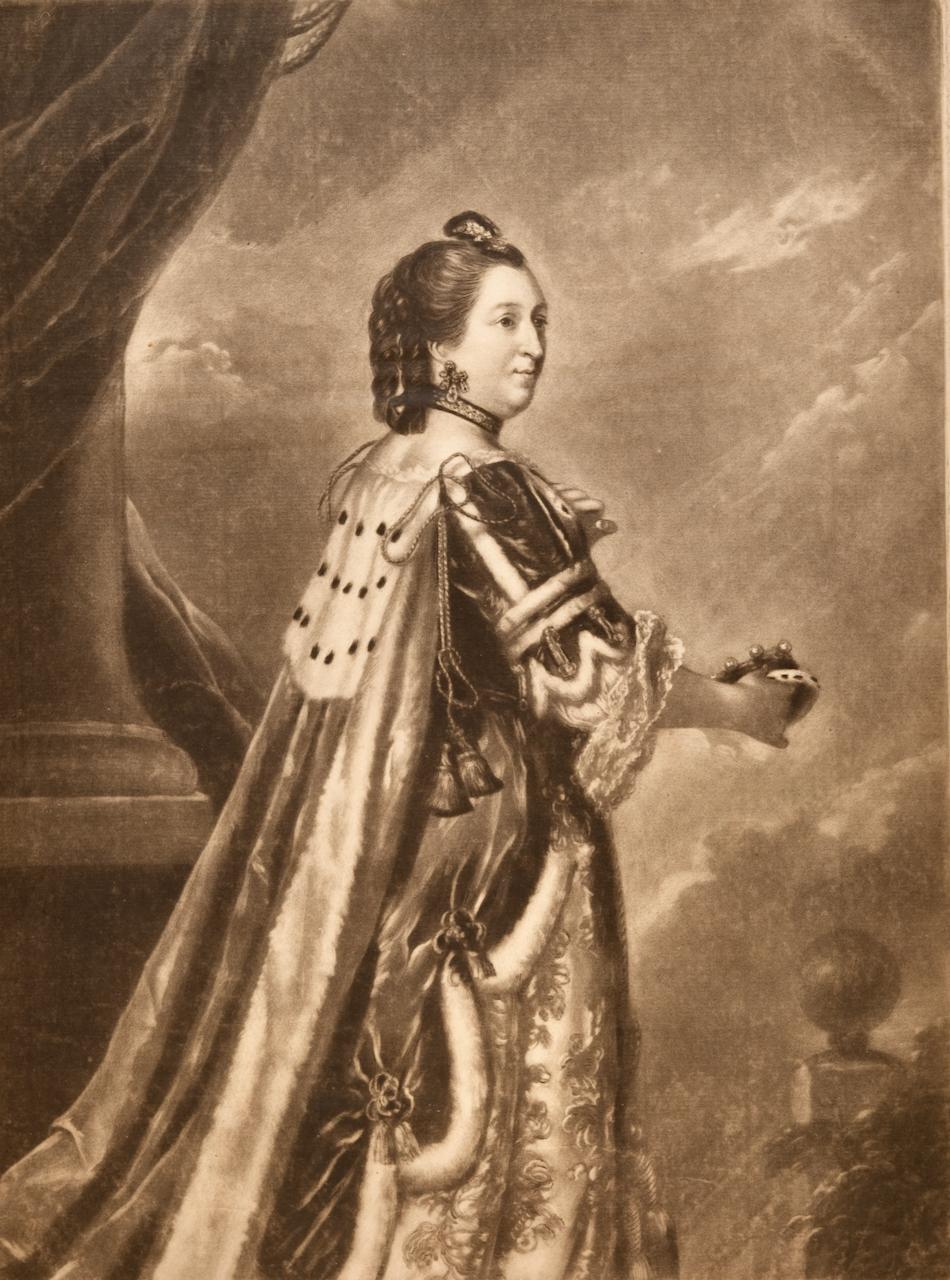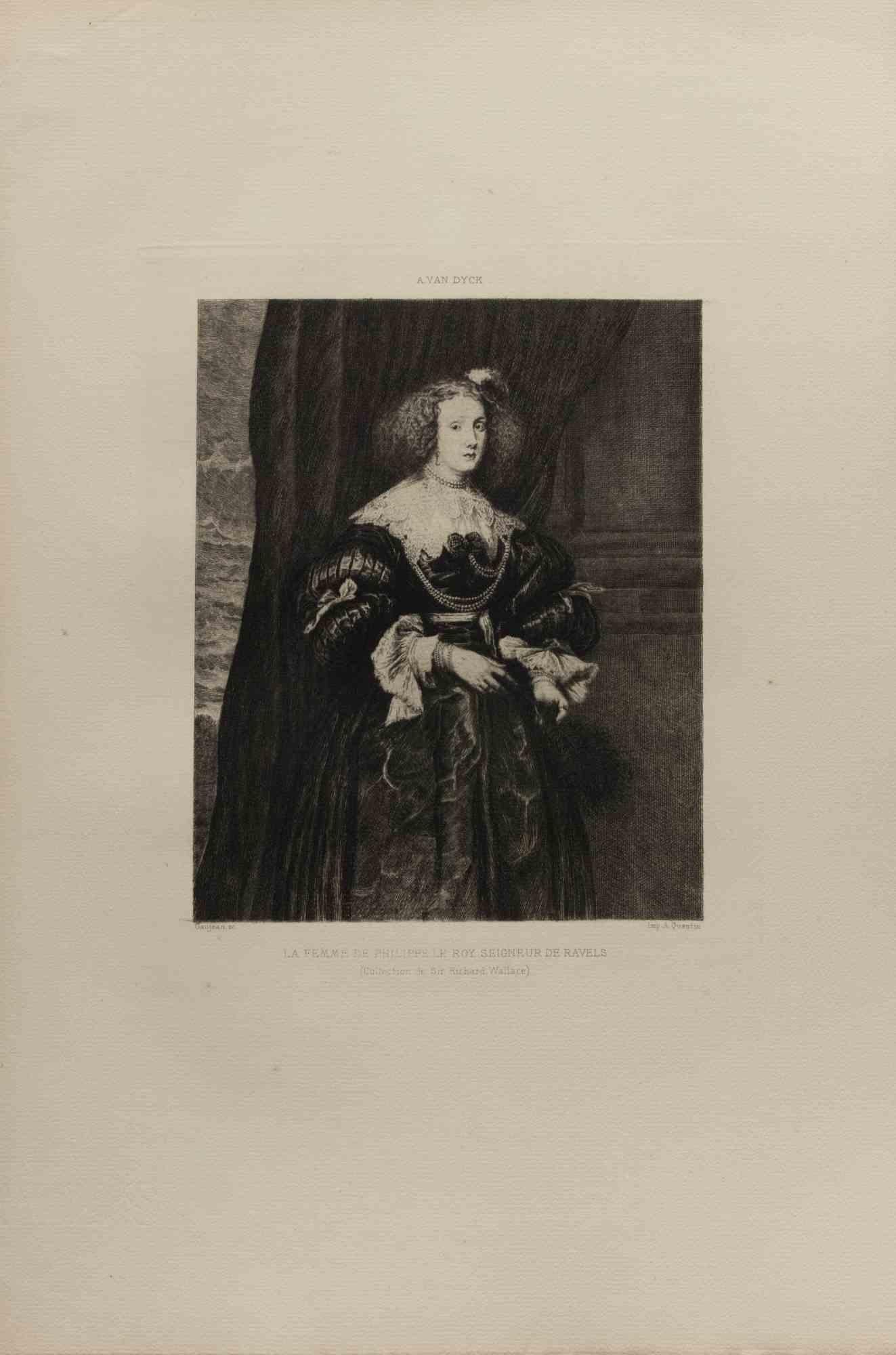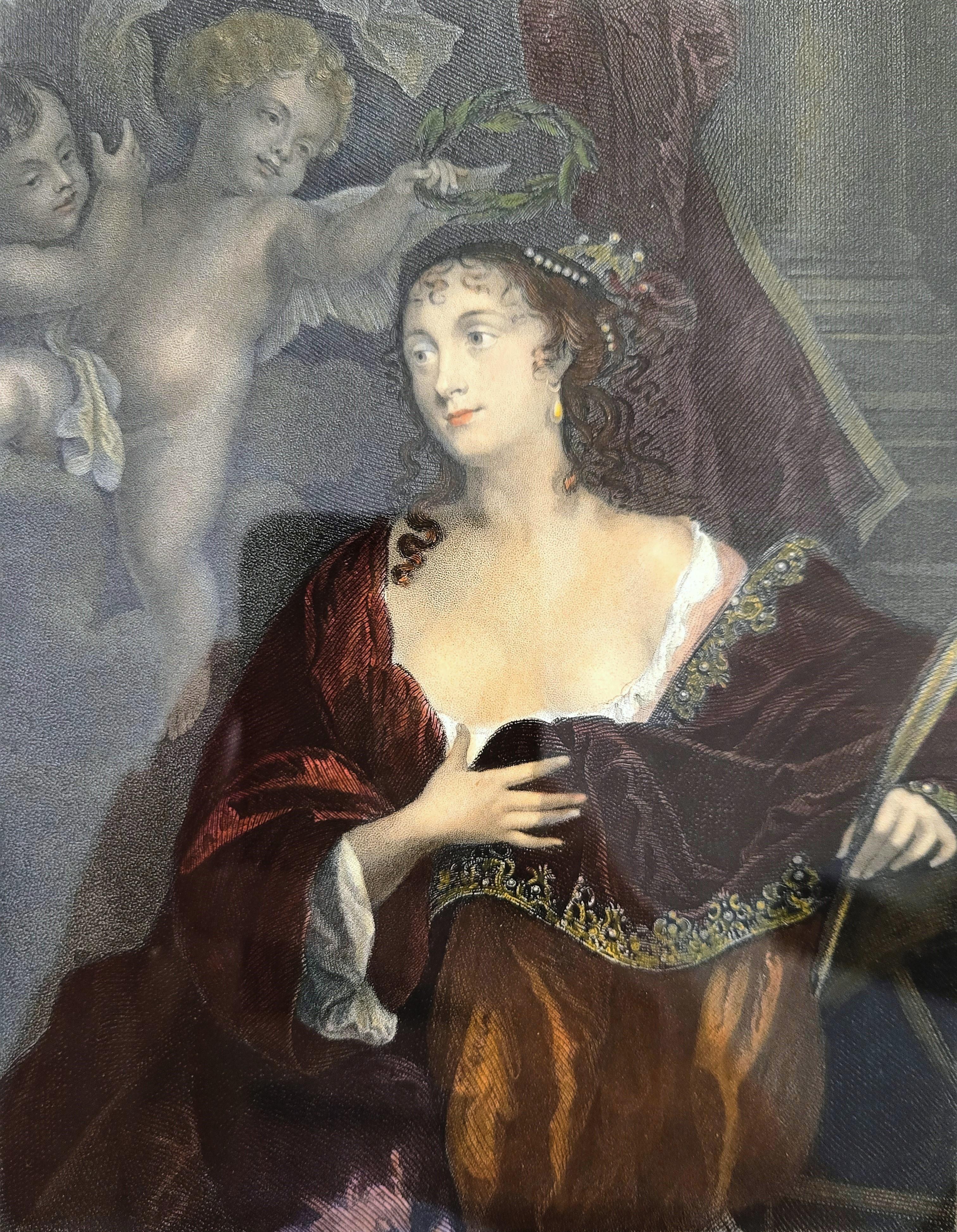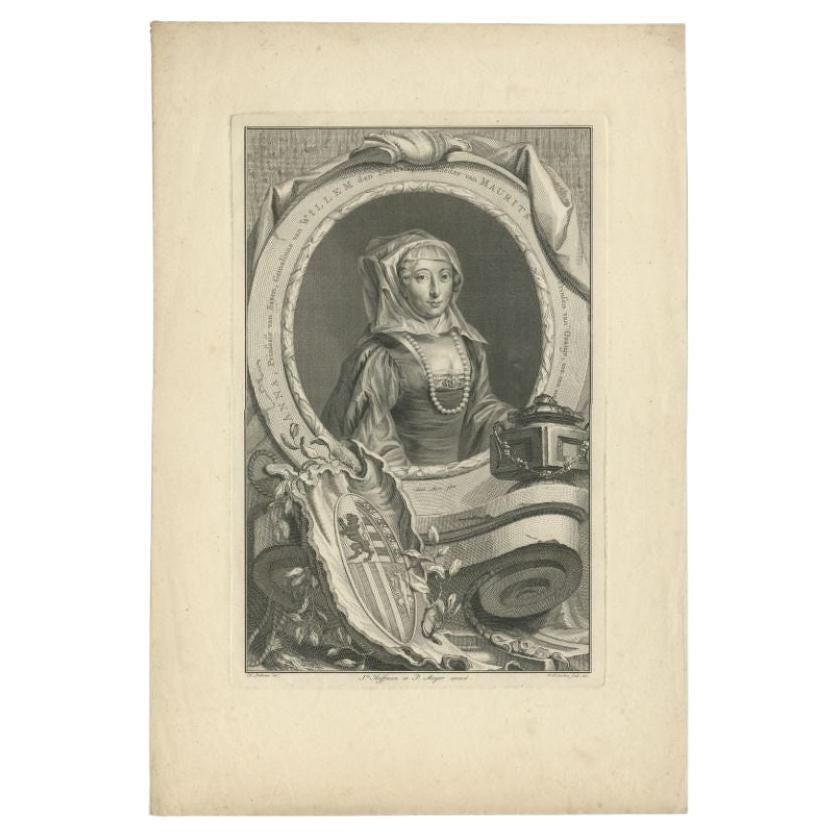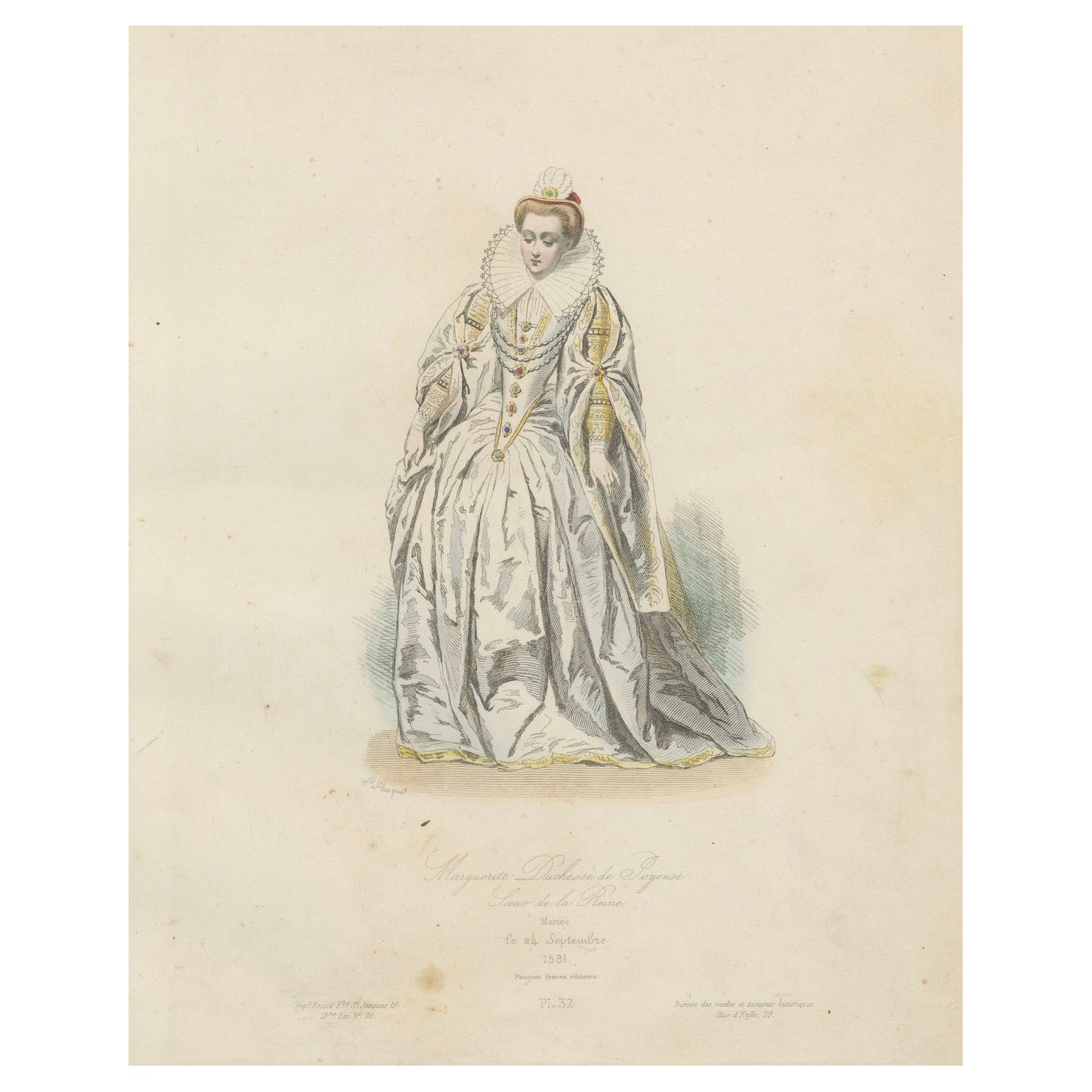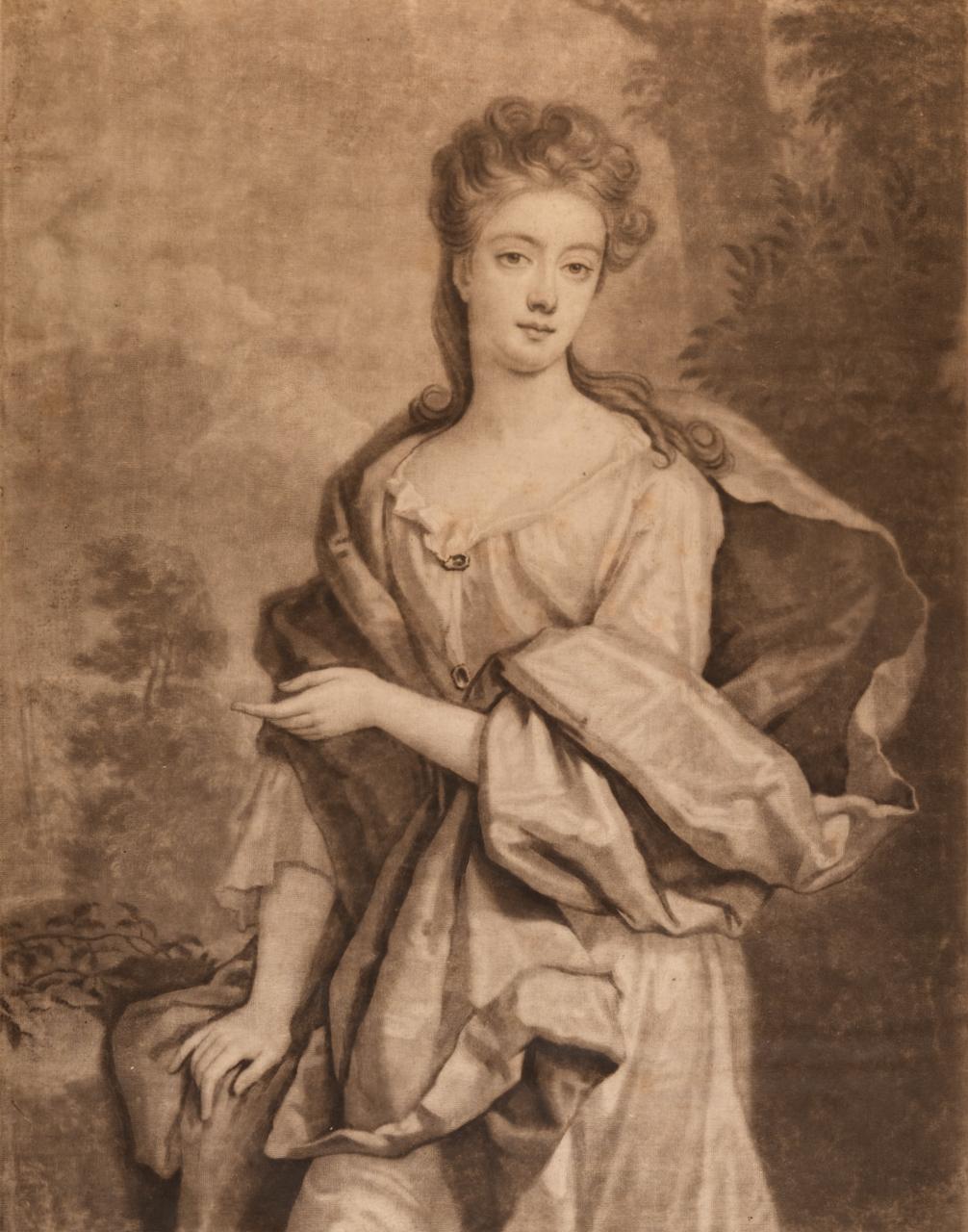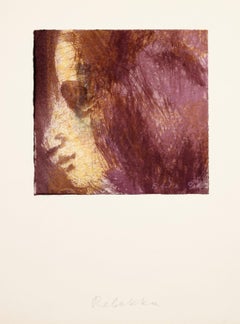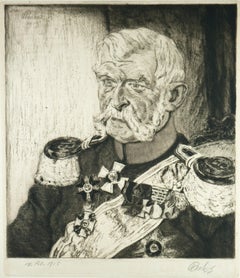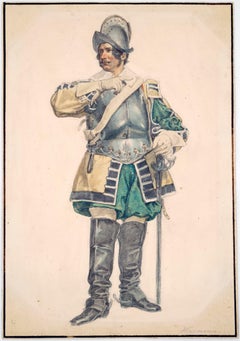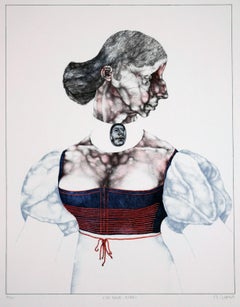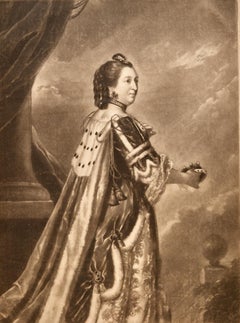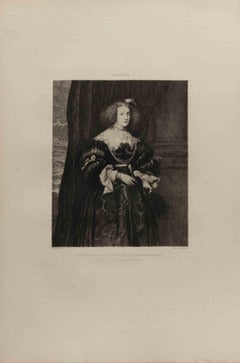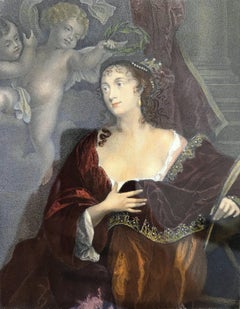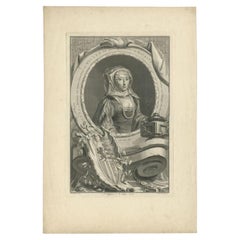Items Similar to Joan of Austria / - The luminosity of the print -
Want more images or videos?
Request additional images or videos from the seller
1 of 7
Gerard EdelinckJoan of Austria / - The luminosity of the print -1707
1707
$454.21
$567.7620% Off
£343.01
£428.7620% Off
€384
€48020% Off
CA$635.33
CA$794.1620% Off
A$695.26
A$869.0720% Off
CHF 364.63
CHF 455.7920% Off
MX$8,309.80
MX$10,387.2620% Off
NOK 4,601.62
NOK 5,752.0220% Off
SEK 4,292.76
SEK 5,365.9420% Off
DKK 2,925.12
DKK 3,656.4020% Off
About the Item
Gérard Edelinck (1640 Antwerp - 1707 Paris), Joan of Austria, 1707. Copperplate engraving, 51.2 cm x 29.8 cm, inscribed below the image: "Jeanne d'Autriche Grande Duchesse de Toscane. Fille de l'Empereur Ferdinand 1.er ["er" superscript] & mére de la Reine Marie de Médicis, naquit à Prague en 1547. & en 1565. elle épousa François premier, Grand Duc de Toscane, et mourut à l'age de 32 ans en 1578". Marked lower left with “Rubens pinxit” as painted by Peter Paul Rubens and lower right with “I. M. Nattier delineavit” and “G. Edelinck eques effigiem Sc.” as drawn by Jean-Marc Nattier and engraved by Gérard Edelinck. The print is the third sheet of the series ‘La Gallerie du Palais du Luxembourg’ published in 1710, which reproduces Rubens' Medici cycle.
- Strong impression with minimal creases in the title page
- The luminosity of the print -
The most renowned French engravers of the time were involved in the prestigious gallery work published in 1710. This work depicts Rubens's Medici cycle at the Palais des Luxembourg, and Gérard Edelinck was considered particularly masterful among these engravers. Created in the year of his death, the engraving illustrates how the artist depicted the materiality of the robes, capturing their shimmering effects of light and shadow. The print captivates with its almost diffuse atmosphere, in which the face's clear precision stands out particularly well.
The print exemplifies the creative power and significance of reproductive graphics. Peter Paul Rubens created the exemplary painting, and the highly sought-after court portraitist Jean-Marc Nattier made the drawing from which Edelinck engraved the print. Thus, it is ultimately a joint work by three extremely talented artists.
About the artist
Gérard Edelinck was born in Antwerp and was educated by the Jesuits. He first studied printmaking with Gaspar Huybrechts from 1652 to 1653, and then became a pupil of Cornelius Galle the Younger. In 1666, Edelinck traveled to Paris, where he worked with François de Poilly, Robert Nanteuil, and Philippe de Champaigne. Edelinck's artistic virtuosity was highly regarded, and he was appointed royal engraver by Louis XIV in 1675. He then moved into an apartment in the Royal Tapestry Manufactory. Louis XIV alone portrayed Edelinck thirteen times. Edelinck became a member of the Academy of Fine Arts in 1677 and was knighted in the Order of St. Michael in 1695. His works were coveted collector's items by the 18th century.
GERMAN VERSION
Gérard Edelinck (1640 Antwerpen - 1707 Paris), Johanna von Österreich, 1707. Kupferstich, 51,2 cm x 29,8 cm, unter der Darstellung mit der Inschrift versehen: „Jeanne d'Autriche Grande Duchesse de Toscane. Fille de l'Empereur Ferdinand 1.er ["er" hochgestellt] & mére de la Reine Marie de Médicis, naquit à Prague en 1547. & en 1565. elle épousa François premier, Grand Duc de Toscane, et mourut à l'age de 32 ans en 1578”. Unten links mit “Rubens pinxit” als von Peter Paul Rubens gemalt und unten rechts mit „I. M. Nattier delineavit“ und „G. Edelinck eques effigiem Sc.“ als von Jean-Marc Nattier gezeichnet und von Gérard Edelinck gestochen ausgewiesen. Bei der Grafik handelt es sich um das dritte Blatt der 1710 publizierte Folge ‚La Gallerie du Palais du Luxembourg‘, die den Medici-Zyklus von Rubens wiedergibt.
- Kräftiger Druck mit minimalen Knickspuren in der Titelei
- Die Leuchtkraft der Grafik -
Bei dem repräsentativen 1710 erschienenen Galeriewerk, das Rubens Medici-Zyklus des Palais des Luxembourg wiedergibt, hatten die renommiertesten französischen Kupferstecher ihrer Zeit mitgewirkt, von denen Gérard Edelinck als besonders meisterhaft galt. Der in seinem Todesjahr angefertigte Stich veranschaulicht, wie der Künstler die Stofflichkeit der Gewänder mit ihren schimmernden Licht-Schatten-Wirkungen innerhalb der Druckgraphik zur Darstellung zu bringen vermochte. Zudem besticht die Grafik durch eine beinahe diffus wirkende Atmosphäre, aus der insbesondere die klare Präzision des Gesichts hervortritt.
Das Blatt ist zugleich ein Beispiel für die Schöpferkraft und den Stellenwert der Reproduktionsgrafik. Ist das vorbildliche Gemälde von Peter Paul Rubens geschafften worden, so fertigte der spätere, äußerst gefragte Hofporträtist Jean-Marc Nattier die Zeichnung an, nach der Edelinck die Grafik gestochen hat, so dass es sich letztlich um ein Gemeinschaftswerk von drei äußerst talentierten Künstlern handelt.
zum Künstler
In Antwerpen geboren und von den Jesuiten erzogen erlernte Gérard Edelinck die Druckgraphik zunächst von 1652 bis 1653 bei Gaspar Huybrechts und wurde anschließend Schüler von Cornelius Galle dem Jüngeren. 1666 ging er nach Paris und arbeite dort mit François de Poilly, Robert Nanteuil und Philippe de Champaigne zusammen. Aufgrund seiner vielgerühmten künstlerischen Virtuosität war er so erfolgreich, dass er von Ludwig XIV. 1675 zum königlichen Kupferstecher ernannt wurde und eine Wohnung in der Königlichen Gobelin-Manufaktur bezog. Allein Ludwig XIV. porträtierte Edelinck dreizehn Mal. 1677 wurde er Mitglied der Kunstakademie und 1695 zum Ritter des Ordens des Hl. Michael geschlagen. Bereits im 18. Jahrhundert waren seine Werke begehrte Sammelobjekte.
- Creator:Gerard Edelinck (1640 - 1707, Flemish)
- Creation Year:1707
- Dimensions:Height: 20.08 in (51 cm)Width: 11.03 in (28 cm)Depth: 0.4 in (1 cm)
- Medium:
- Movement & Style:
- Period:1700-1709
- Condition:
- Gallery Location:Berlin, DE
- Reference Number:1stDibs: LU2438216369112
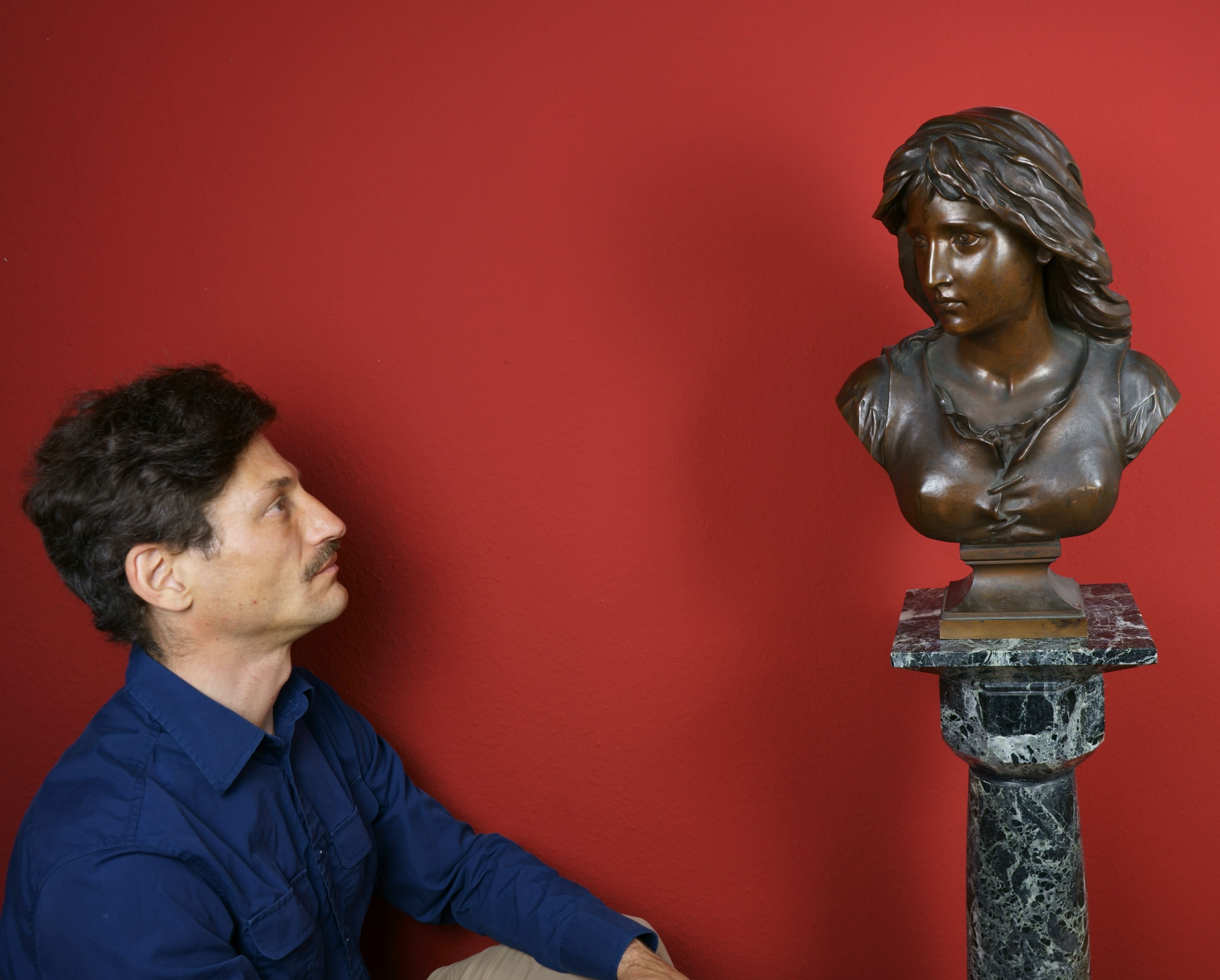
About the Seller
5.0
Vetted Professional Seller
Every seller passes strict standards for authenticity and reliability
Established in 2014
1stDibs seller since 2023
22 sales on 1stDibs
- ShippingRetrieving quote...Shipping from: Berlin, Germany
- Return Policy
More From This Seller
View AllRebekka / - Rebekka's Appearance -
Located in Berlin, DE
Emil Wachter (1921 Neuburgweiser - 2012 Karlsruhe), Rebekka, 1987. Watercolor mounted on cardboard, 13.5 (height) x 14 cm (width). Signed “E.[mil] Wa[chter]” in pencil within the ima...
Category
1980s Realist Figurative Drawings and Watercolors
Materials
Paper
$369 Sale Price
25% Off
General Wilhelm von Blume - Visionary retrospective -
Located in Berlin, DE
Bernhard Pankok (1872 Münster - 1943 Baierbrunn), General Wilhelm von Blume, 1915, aquatint etching, 34 x 29.5 cm (sheet size), 26 x 22 cm (plate size), signed in the plate at upper left, in pencil at lower right and dated in pencil at lower left.
- At lower left old collection stamp, at the right broad margin with a small spot, otherwise very good condition.
About the artwork
The 1915 aquatint etching of General Wilhelm von Blume is based on a 1912 oil painting in the LWL-Museum für Kunst und Kultur in Münster. A second oil portrait of the general by Pankok is in the Staatsgalerie Stuttgart. When Pankok painted the first oil portrait in 1912, the general had already been retired for 16 years. It is therefore a retrospective portrait. Accordingly, the orientation of his head is such that he is looking back in both the oil painting and the etching. Without fixing on anything in particular, he looks thoughtfully inwards and reflects on his life. Uniformed and highly endowed, it is his military activities in particular that he is reviewing attentively and, as his gaze reveals, quite critically.
Pankok has literally written the sum of his experiences on Wilhelm von Blume's face: The physiognomy is a veritable landscape of folds, furrows, ridges and gullies, all the more striking against the flat background. It is clear that each of the medals was also won through suffering. However, by breaking the boundaries of the picture, his bust appears as an unshakable massif, which gives the general a stoic quality.
The fact that the design of the portrait was important to Pankok can be seen from the different versions, the present sheet being the third and probably final revision, which Pankok dates precisely to 18 February 1915. Compared with the previous state, the light background now has a dark area against which the sitter's face stands out, the dark background in turn combining with the uniform to create a new tension in the picture.
Pankok's taking up of the portrait of the high-ranking military veteran and its graphic reproduction can also be seen in relation to the First World War, which had broken out in the meantime. In the face of modern weapons of mass destruction, Wilhelm von Blume's warfare and military writings were relics of a bygone, more value-oriented era.
About the artist
After studying at the Düsseldorf Art Academy from 1889 to 1891 under Heinrich Lauenstein, Adolf Schill, Hugo Crola, and Peter Janssen the Elder, Bernhard Pankok went to Munich in 1892, where he worked primarily as a graphic artist for the two major Jugendstil magazines "Pan" and "Jugend," which established his artistic success. Through this work he met Emil Orlik, with whom he had a lifelong friendship.
In 1897, he exhibited his first furniture, and in 1898, together with Richard Riemerschmid, Bruno Paul and Hermann Obrist...
Category
1910s Realist Portrait Prints
Materials
Etching
$454 Sale Price
20% Off
The actor Karl Seydelmann, probably as Max Piccolomini / - Theatrical Realism -
Located in Berlin, DE
Theodor Hosemann (1807 Brandenburg - 1875 Berlin), The actor Karl Seydelmann probably as Max Piccolomini, around 1840. Watercolor with pencil, 20.5 cm (height) x 14.7 cm (width), sig...
Category
1840s Realist Figurative Drawings and Watercolors
Materials
Paper
The Dirndl Model / - The strangeness of the homeland -
By Reiner Schwarz
Located in Berlin, DE
Reiner Schwarz (*1940 Hirschberg), The Dirndl Model, 1969. Lithograph, 33 cm x 26 (depiction), 59 cm x 42 cm (sheet size), signed “R.[einer] Schwarz” in pencil lower right, dated “[1...
Category
1960s Surrealist Figurative Prints
Materials
Paper
$236 Sale Price
20% Off
The Lady with the Dog / - Like the master, so the dog -
By Reiner Schwarz
Located in Berlin, DE
Reiner Schwarz (*1940 Hirschberg), The Lady with the Dog, 1971. Lithograph, 33 cm x 26 (image), 59 cm x 42 cm (sheet size), signed in pencil at lower right "R.[ein] Schwarz", dated "...
Category
1960s Surrealist Figurative Prints
Materials
Paper
$264 Sale Price
20% Off
Death as a servant / - Concise congeniality -
Located in Berlin, DE
Alfred Rethel after (1816 Diepenbenden - 1859 Düsseldorf), Death as a servant, around 1920. Color woodcut by Oskar Bangemann after a drawing by Rethel created around 1845 on handmade...
Category
1910s Realist Figurative Prints
Materials
Paper
$227 Sale Price
20% Off
You May Also Like
Elizabeth, Countess of Northumberland: Mezzotint After a Painting by J. Reynolds
By Joshua Reynolds
Located in Alamo, CA
This is an 18th century mezzotint portrait of Elizabeth, Countess of Northumberland, Baroness Percy by Richard Houston after a painting by Joshua Reynolds, published in London by Robert Sayer in 1763. It is a rare, full length portrait of Elizabeth, who was known as Lady Betty. Lady Betty stands, facing to the right, holding her coronet, and wearing her peeress’s ermine and velvet robes over a brocade dress. In the background are a column, a billowing drape, and the grounds of Alnwick Castle...
Category
Mid-18th Century Portrait Prints
Materials
Mezzotint
$2,060 Sale Price
20% Off
La Femme de Philippe Le Roy Seigneur.. - Etching by Felix-Augustin Milius - 1872
Located in Roma, IT
Etching realized by Félix Milius d'après Van Dyck in 1872.
Very good condition.
Category
1870s Modern Portrait Prints
Materials
Etching
Susan, Lady Belasyse /// Memoirs of Count Grammont Royal Portrait Engraving Art
Located in Saint Augustine, FL
Artist: Anthony Hamilton (British-French, 1645-1719)
Title: "Susan, Lady Belasyse" (Plate 45)
Portfolio: Memoirs of Grammont
Year: 1808 (First edition)
Medium: Original Stipple Engra...
Category
Early 1800s Romantic Portrait Prints
Materials
Engraving, Intaglio
Antique Portrait of Anna of Saxony, Wife of William of Orange, 1757
Located in Langweer, NL
Antique portrait titled 'ANNA, Prinsesse van Saxen, Gemalinne van WILLEM den Eersten, Moeder van MAURITS Prinsen van Oranje, enz. enz. enz'. Portrait of Anna of Saxony, wife of William of Orange...
Category
Antique 18th Century Dutch Prints
Materials
Paper
Antique French Costume Print of Marguerite Duchesse de Savoie, Renaissance Dress
Located in Langweer, NL
Antique French Costume Print of Marguerite Duchesse de Savoie, Renaissance Dress, 19th Century
Description:
This graceful antique French costume print, titled “Marguerite Duchesse d...
Category
Antique 1860s Prints
Materials
Paper
The Duchess of St. Albans: A 17th C. Portrait After a Kneller Painting
By (After) Sir Godfrey Kneller
Located in Alamo, CA
This is a 17th century engraved mezzotint portrait of the Duchess of St. Albans by John Smith, after a painting by Sir Godfrey Kneller. It was published in London by John Boydell in 1694.
The Duchess of St. Albans (1642-1712) was a woman named Diana de Vere. She was born in 1642, the daughter of Aubrey de Vere, the 20th Earl of Oxford. In 1662, she married Charles Beauclerk, the illegitimate son of King Charles II and his mistress, Nell Gwyn. As a result of her marriage, Diana became the Duchess of St. Albans, and she and Charles had several children together. Diana was known for her beauty and charm, and she was a prominent figure in the court of King Charles II. Despite her husband's illegitimate birth, Diana was highly respected in the royal court and was known for her intelligence and wit. She was a patron of the arts and supported many artists and writers of the time. Diana lived through a tumultuous period of English history, including the Great Fire of London and the Glorious Revolution, which saw King James II replaced by William of Orange. She died in 1712 at the age of 70 and was buried in Westminster Abbey. Descendants of Diana and her husband, who was an illegitimate son of King Charles II, include Diana, Princess of Wales and her son William, Duke of Cambridge.
An author wrote of her: "The line of Vere, so long renown’d in arms,
Concludes with luster in St. Albans’s charms;
Her conquering eyes have made their race complete,
It rose in valor, and in beauty set."
This striking mezzotint engraving depicts Diana, Duchess of St Albans in a three-quarter length pose, standing, wearing loose flowing dress and a wrap. She has a very serene, calm appearance as she is looking straight at the viewer. There is a landscape of trees in the background. The print is adhered in the corners to an archival backing, which is itself adhered in the upper corners to a larger backing. The print is trimmed to just beyond the plate mark. There are areas of discoloration in the margins and in the inscription area, but the print is otherwise in very good condition. The sheet measures 14.5" high and 10" wide. This mezzotint is held by multiple museums and institutions, including The British Museum, The National Portrait Gallery London, The Fine Arts Museum of Boston, The Lewis Walpole Library at Yale, The Yale Center for British Art, The Fitzwilliam Museum at Cambridge and The National Galleries of Scotland. The original Kneller painting is part of the British Royal Collection Trust and hangs in the King's Private Dining Room at Hampton Court Palace.
Sir Godfrey Kneller (1646-1723) was a leading portrait painter of his time, particularly renowned for his depictions of the British aristocracy and royalty. He was born in Lübeck, Germany, and trained in Amsterdam under the painter Ferdinand Bol...
Category
Late 17th Century Portrait Prints
Materials
Mezzotint
$2,220 Sale Price
20% Off
